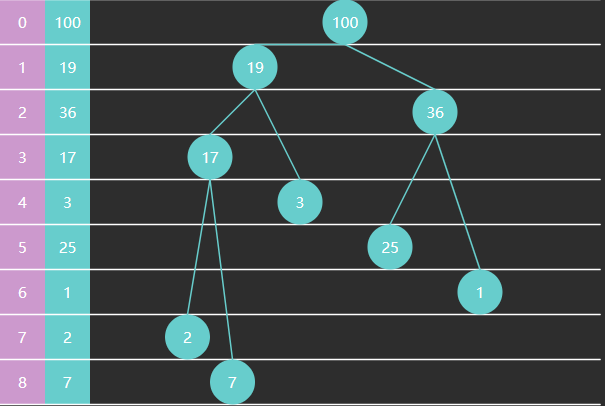由于Go没有直接提供像 Java 的 PriorityQueue 或 C++ 的 std::priority_queue 这样的封装好的堆数据结构,需要自己手动实现一些东西
Go 提供了 container/heap 包,允许开发者根据具体需求自定义堆的行为。
以下是我写的215. 数组中的第K个最大元素,使用 container/heap 包来实现堆的效果
1 | type hp struct { |
匿名字段
这里的IntSlice是一个anonymous field,也就是匿名字段,如果我们写的是
1 | type hp struct { |
这样就不是继承,也就没有Len, Less, Swap方法
匿名字段相当于结构体里有一个和类型同名的字段也就是IntSlice,下面这样写也是ok的,但也不算继承,同样没有Len, Less, Swap方法
1 | type hp struct { |
也就是说,Go语言中只有结构体里单放一个类型才叫继承
定义堆还可以是以下这种方式
1 | type hp []int |
Go中不建议同时使用value receiver和pointer receiver
这里的heap.Init, heap.Pop中必须要传递&h,因为我们写的方法Len, Less, Swap, Push, Pop都是写的pointer receiver,而Init, Pop底层会调用我们写的这些方法,所以应该传递指针
同时,Push和Pop方法也只能传递指针
不然会提示 Assignment to the method receiver doesn't propagate to other calls
在 Go 语言中,方法接收者有两种形式:指针接收者(pointer receiver)和值接收者(value receiver)
指针接收者
- 修改接收者的内部状态:
- 当一个方法通过指针接收者调用时,它可以直接修改接收者的内部状态。
- 如果使用值接收者,方法接收的是接收者的一个副本,任何对副本的修改都不会影响原始接收者。
- 效率:
- 对于大型结构体,使用指针接收者可以避免每次调用方法时都复制整个结构体,从而提高效率。
结合代码解释
- 指针接收者的使用:
Push方法使用指针接收者*hp,因此它可以直接修改hp的内部切片。Pop方法同样使用指针接收者*hp,以便直接修改切片的长度。
- 如果使用值接收者:
- 如果将
Push和Pop方法的接收者改为值接收者h hp,则这些方法将对hp的副本进行操作,而不是原始对象。 - 任何对副本的修改都不会影响调用这些方法时传递的原始
hp对象,从而导致修改无法生效。
- 如果将
值接收者的问题
假设我们将 Push 和 Pop 方法改为值接收者,代码如下:
1 | func (h hp) Push(v any) { |
在这种情况下,Push 和 Pop 方法对 h 的修改都不会反映到原始的 hp 对象上。具体来说:
Push方法内部的append操作只修改了h的副本,并没有修改原始的hp对象。Pop方法内部对h的切片操作同样只修改了副本。
Go中的container/heap包是面向对象的风格,主要通过传入一个实现了 heap.Interface 接口的类型实例,以确保传入的类型具有堆操作所需的方法。这样可以在没有泛型的情况下自定义堆的类型和行为。
继承与重写
heap.Interface 定义了一个堆需要实现的基本方法:
1 | type Interface interface { |
heap.Interface继承了sort.Interface,这是标准库中用于排序的接口
1 | type Interface interface { |
所以我们传入的实例至少需要实现Push, Pop, Len, Less, Swap这五个方法
对于Int类型,我们可以让我们自己写的堆继承sort.IntSlice
1 | // IntSlice attaches the methods of Interface to []int, sorting in increasing order. |
这样就只用写Push和Pop方法了
1 | // MinHeap 继承自IntSlice, 而IntSlice默认是用Less方法,继承了IntSlice中的Less方法,所以默认创建的是小顶堆 |
但要注意这样实现的堆是最小堆(Min_Heap),因为Less方法中写的是x[i] < x[j],那么Less如何理解呢?可以认为x[i]和x[j]是数组中前后相邻的两个数,而Less要实现的效果就是前面的x[i]小于后面的x[j],这样就是升序,也就是最小堆。
这种情况下,想要实现大顶堆就需要额外重写Less方法
1 | // Less 重写IntSlice中的Less方法 |
这样GoLand旁边也会显示一个蓝色的O表示重写
上浮与下沉
这时你可能会有疑问,我都把Push和Pop写好了,不能直接调我写的Push和Pop吗?
不可以,必须要用heap.Push和heap.Pop, 虽然heap.Push和heap.Pop底层是调用我们写的Push和Pop,
接调用我们写的Push和Pop,并不是按照堆的方式添加和弹出,仅仅只是简单的添加和弹出
1 | // Push pushes the element x onto the heap. |
我们相当于只用告诉堆添加和弹出的方式就行了,而heap包下主要做的是上浮和下沉的操作(up and down)
可以看到这里的down用到了我们写的Less方法,而这里的语义就不仅仅是数组中前面的元素应该比后面大还是小,而且前面的优先级比后面大
这段源码中,只有j2比j1位置的元素的优先级高,我们才让j = j2,只有j比i的优先级高,也就是比原先的parent高,才往下作交换并循环
1 | func down(h Interface, i0, n int) bool { |
这里我们写的代码为什么是获取IntSlice的最后一个元素并移除,而不是第一个呢
1 | func (h *hp) Pop() any { |
我们来看看Pop的底层实现
1 | func Pop(h Interface) any { |
主要是将0号元素和最后一个元素对调了,这时只需要将最后一个元素弹出就可以获取优先级最高的元素了
